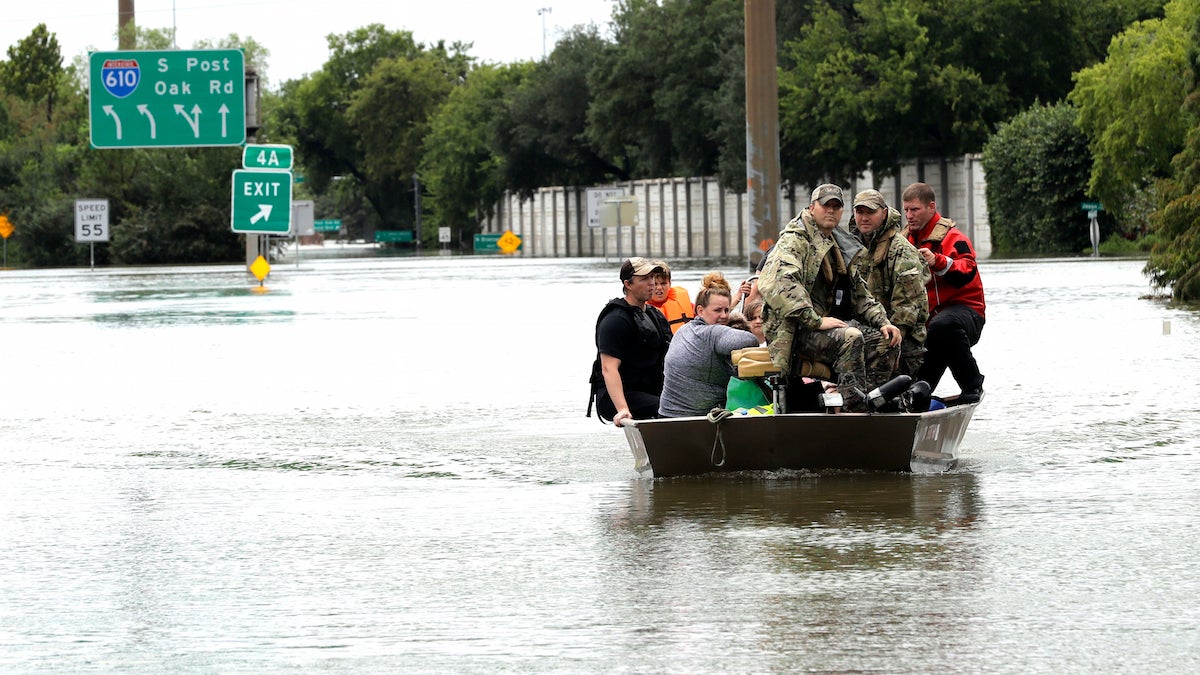Hurricane Harvey the latest threat to flood-prone Houston

Residents are rescued from their homes surrounded by floodwaters from Tropical Storm Harvey on Sunday, Aug. 27, 2017, in Houston, Texas. (AP Photo/David J. Phillip)
Hurricane Harvey slammed into the Texas coast some 175 miles (280 kilometers) from Houston, but the nation’s fourth-largest city has never needed a direct strike from a catastrophic storm to flood.
Regularly inundated by floodwaters ever since its settlement in the mid-1800s, Houston looked on warily even before Harvey roared ashore. In Houston, the chronic deluges that have repeatedly swamped its neighborhoods are getting worse and more costly — not just for locals, but for federal taxpayers.
An Associated Press analysis of government data found last year that if the county that is home to Houston were a state, it would have ranked in the top five or six in every category of repeat flood losses. That’s defined as any property with two or more losses in a 10-year period each totaling at least $1,000.
Nationally, repeat federal flood relief payouts averaged about $3,000 per square mile (2.5 square kilometers). But in greater Houston, the payouts were nearly a whopping $500,000 per square mile (2.5 square kilometers).
Harvey, which blasted ashore as a major Category 4 hurricane before weakening to a tropical storm, has swamped roads and paralyzed neighborhoods throughout the city. Houston Mayor Sylvester Turner said more than 2,000 calls for help had been received by midday Sunday. Flooding was so bad that residents were being urged to seek refuge on their roofs.
The National Weather Service said Sunday that some parts of Houston may receive a Texas record of 50 inches (1,270 millimeters) of rain.
Here’s a look at some of the reasons Houston has been so susceptible to flooding:
___
GEOGRAPHY
Founded on the banks of the Buffalo Bayou, Houston barely rises above sea level. Making matters worse, its flat terrain and clay soil are prone to the flooding of a humid climate that produces extreme rainfall. At least three dozen major floods have been recorded since Houston’s founding, including one in April 2016 that claimed eight lives.
___
INADEQUATE INFRASTRUCTURE
Floods prompted the U.S. Army Corps of Engineers to build reservoirs in the 1940s in the western area of Harris County, which encompasses Houston. That addressed some problems, yet few notable flood-control efforts have been undertaken since, experts told the AP last year. Houston in recent decades has focused on improving drainage and building thousands of detention ponds, concrete-lined pools capturing stormwater and piping it out. But, residents say, some developers have skimped on the flood-prevention systems.
___
MANAGING GROWTH
In the last quarter century, greater Houston has added a million people and its commercial development has cut in half the amount of wetlands per capita that could soak up stormwater runoff. Paved land generates five times more runoff, and those surfaces in Harris County increased by more than 25 percent during that same time, researchers have said. Houston is also the only major U.S. city without zoning, and critics say local leaders have been pro-developer.
___
CLIMATE SHIFTS
As if Houston’s natural elements weren’t challenging enough, intense downpours, measuring at least 10 inches (250 millimeters), have doubled in frequency during the last three decades. Rising average temperatures have packed 7 percent more moisture into the atmosphere over Houston. Contributing to that is warmer water in the Gulf of Mexico.
WHYY is your source for fact-based, in-depth journalism and information. As a nonprofit organization, we rely on financial support from readers like you. Please give today.




